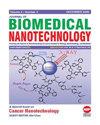白藜芦醇抑制纳米颗粒基质相互作用分子 2 调控 miR-20b-5p 信号通路,从而改善心肌缺血再灌注损伤过程中的线粒体功能
IF 2.9
4区 医学
Q1 Medicine
引用次数: 0
摘要
糖尿病心肌缺血再灌注(IR)可引起严重的心肌损伤。本研究将白藜芦醇纳米颗粒用于糖尿病心肌IR大鼠模型损伤,以评估其对线粒体功能的影响。将大鼠模型分为假手术组、IR组、IR+RES组、IR+RES+mir-NC组、IR+RES+miR-20b-5p抑制剂组。各组5只大鼠采用TTC法测定心肌梗死面积,超声检测左室收缩末内径(LVIDs)和舒张末内径(LVIDd), HE染色分析心肌病。分析miR-20b-5p与基质相互作用分子2 (STIM2)表达、心肌细胞增殖、凋亡、细胞活力、线粒体功能以及miR-20b-5p与STIM2之间的关系。成功制备了白藜芦醇纳米颗粒。IR+RES组大鼠心肌梗死面积、LVIDd、LVIDs均降低(与IR组比较),但高于sham组。miR-20b-5p的表达在IR+RES组也升高(与IR组相比),miR-20b-5p抑制剂降低了上述指标(与IR+RES组相比,P <0.05)。使用RES纳米颗粒后,IR+RES+miR-20b-5p拮抗剂组大鼠心肌变化较小(与IR组相比),STIM2表达低于IR组(P < 0.05)。RES纳米颗粒可以增强心肌细胞线粒体功能和细胞活力,提高细胞增殖率,降低细胞凋亡率(与IR组相比,P <0.05)。用RES纳米颗粒干扰糖尿病大鼠心肌IR后,发现其通过调节miR-20b-5p信号通路抑制STIM2,改善线粒体。本文章由计算机程序翻译,如有差异,请以英文原文为准。
Resveratrol Inhibited Nanoparticles Stromal Interaction Molecule 2 in Regulating miR-20b-5p Signaling Pathway to Improve Mitochondrial Function During Myocardial Ischemia-Reperfusion Injury
Myocardial ischemia-reperfusion (IR) in diabetes can cause severe myocardial damages. In this study, resveratrol (RES) nanoparticles were used in diabetic myocardial IR rat model injury to assess its effect on mitochondria function. Rat models were assigned into sham group, IR group,
IR+RES group, IR+RES+mir-NC group, and IR+RES+miR-20b-5p inhibitor group. Myocardial infarction area was measured by TTC in 5 rats from each group, and ultrasound was used to detect left ventricular end-systolic internal diameters (LVIDs) and end-diastolic internal diameters (LVIDd), along
with analysis of cardiomyopathy by HE staining. miR-20b-5p and Stromal interaction molecule 2 (STIM2) expressions, cardiomyocyte proliferation, apoptosis, cell viability, mitochondrial function, and relationship between miR-20b-5p and STIM2 were also analyzed. Resveratrol (RES) nanoparticles
were prepared successfully. Myocardial infarct size, LVIDd and LVIDs of rats in IR+RES group decreased (vs. IR group), but were higher than sham group. miR-20b-5p expression also increased in the IR+RES group (vs. IR group), and the above indicators were decreased by the miR-20b-5p inhibitor
(vs. IR+RES group, P <0.05). The myocardial changes in rats from the IR+RES+miR-20b-5p antagomir group were smaller (vs. IR group), while STIM2 expression was lower than in the IR group after using the RES nanoparticles (P < 0.05). RES nanoparticles can thus enhance mitochondrial
function and cell viability of cardiomyocytes, increasing cell proliferation rate and decreasing apoptosis rate (vs. IR group,P <0.05). After using the RES nanoparticles to interfere with myocardial IR in the diabetic rats, they were found to inhibit STIM2 and improve mitochondria
by regulating miR-20b-5p signaling pathway.
求助全文
通过发布文献求助,成功后即可免费获取论文全文。
去求助
来源期刊
CiteScore
4.30
自引率
17.20%
发文量
145
审稿时长
2.3 months
期刊介绍:
Information not localized

 求助内容:
求助内容: 应助结果提醒方式:
应助结果提醒方式:


